JEEP COMPASS 2019 Owner handbook (in English)
Manufacturer: JEEP, Model Year: 2019, Model line: COMPASS, Model: JEEP COMPASS 2019Pages: 362, PDF Size: 6.23 MB
Page 261 of 362
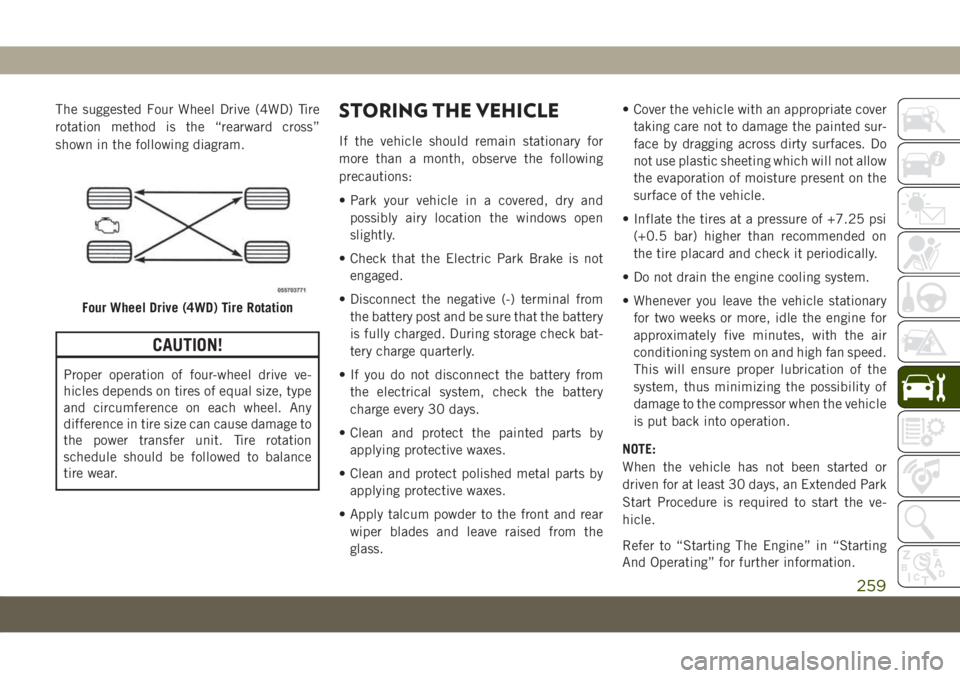
The suggested Four Wheel Drive (4WD) Tire
rotation method is the “rearward cross”
shown in the following diagram.
CAUTION!
Proper operation of four-wheel drive ve-
hicles depends on tires of equal size, type
and circumference on each wheel. Any
difference in tire size can cause damage to
the power transfer unit. Tire rotation
schedule should be followed to balance
tire wear.
STORING THE VEHICLE
If the vehicle should remain stationary for
more than a month, observe the following
precautions:
• Park your vehicle in a covered, dry and
possibly airy location the windows open
slightly.
• Check that the Electric Park Brake is not
engaged.
• Disconnect the negative (-) terminal from
the battery post and be sure that the battery
is fully charged. During storage check bat-
tery charge quarterly.
• If you do not disconnect the battery from
the electrical system, check the battery
charge every 30 days.
• Clean and protect the painted parts by
applying protective waxes.
• Clean and protect polished metal parts by
applying protective waxes.
• Apply talcum powder to the front and rear
wiper blades and leave raised from the
glass.• Cover the vehicle with an appropriate cover
taking care not to damage the painted sur-
face by dragging across dirty surfaces. Do
not use plastic sheeting which will not allow
the evaporation of moisture present on the
surface of the vehicle.
• Inflate the tires at a pressure of +7.25 psi
(+0.5 bar) higher than recommended on
the tire placard and check it periodically.
• Do not drain the engine cooling system.
• Whenever you leave the vehicle stationary
for two weeks or more, idle the engine for
approximately five minutes, with the air
conditioning system on and high fan speed.
This will ensure proper lubrication of the
system, thus minimizing the possibility of
damage to the compressor when the vehicle
is put back into operation.
NOTE:
When the vehicle has not been started or
driven for at least 30 days, an Extended Park
Start Procedure is required to start the ve-
hicle.
Refer to “Starting The Engine” in “Starting
And Operating” for further information.
Four Wheel Drive (4WD) Tire Rotation
259
Page 262 of 362
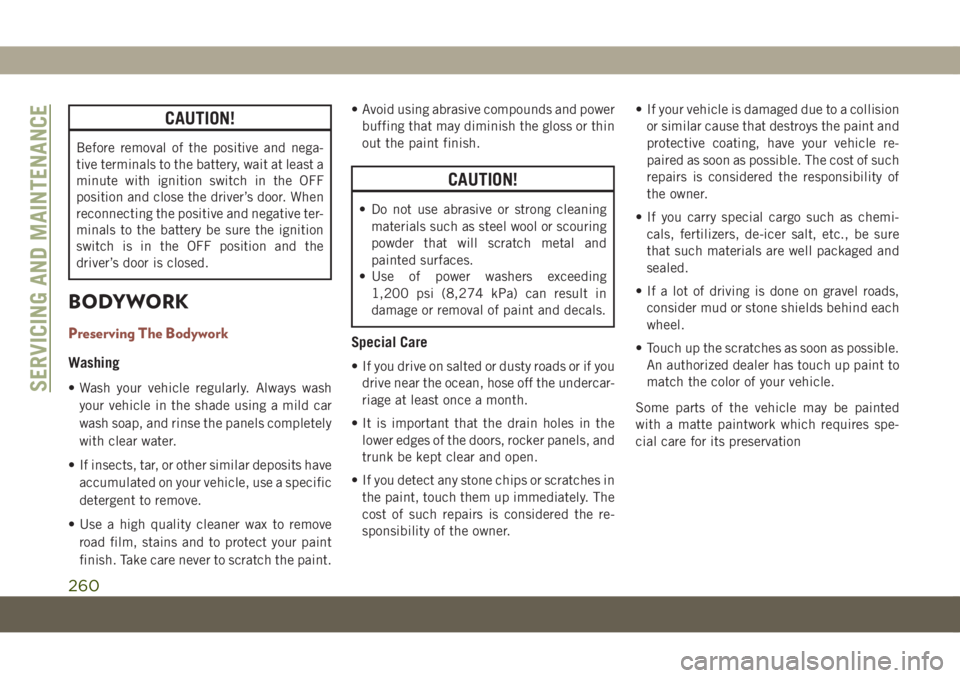
CAUTION!
Before removal of the positive and nega-
tive terminals to the battery, wait at least a
minute with ignition switch in the OFF
position and close the driver’s door. When
reconnecting the positive and negative ter-
minals to the battery be sure the ignition
switch is in the OFF position and the
driver’s door is closed.
BODYWORK
Preserving The Bodywork
Washing
• Wash your vehicle regularly. Always wash
your vehicle in the shade using a mild car
wash soap, and rinse the panels completely
with clear water.
• If insects, tar, or other similar deposits have
accumulated on your vehicle, use a specific
detergent to remove.
• Use a high quality cleaner wax to remove
road film, stains and to protect your paint
finish. Take care never to scratch the paint.• Avoid using abrasive compounds and power
buffing that may diminish the gloss or thin
out the paint finish.
CAUTION!
• Do not use abrasive or strong cleaning
materials such as steel wool or scouring
powder that will scratch metal and
painted surfaces.
• Use of power washers exceeding
1,200 psi (8,274 kPa) can result in
damage or removal of paint and decals.
Special Care
• If you drive on salted or dusty roads or if you
drive near the ocean, hose off the undercar-
riage at least once a month.
• It is important that the drain holes in the
lower edges of the doors, rocker panels, and
trunk be kept clear and open.
• If you detect any stone chips or scratches in
the paint, touch them up immediately. The
cost of such repairs is considered the re-
sponsibility of the owner.• If your vehicle is damaged due to a collision
or similar cause that destroys the paint and
protective coating, have your vehicle re-
paired as soon as possible. The cost of such
repairs is considered the responsibility of
the owner.
• If you carry special cargo such as chemi-
cals, fertilizers, de-icer salt, etc., be sure
that such materials are well packaged and
sealed.
• If a lot of driving is done on gravel roads,
consider mud or stone shields behind each
wheel.
• Touch up the scratches as soon as possible.
An authorized dealer has touch up paint to
match the color of your vehicle.
Some parts of the vehicle may be painted
with a matte paintwork which requires spe-
cial care for its preservation
SERVICING AND MAINTENANCE
260
Page 263 of 362
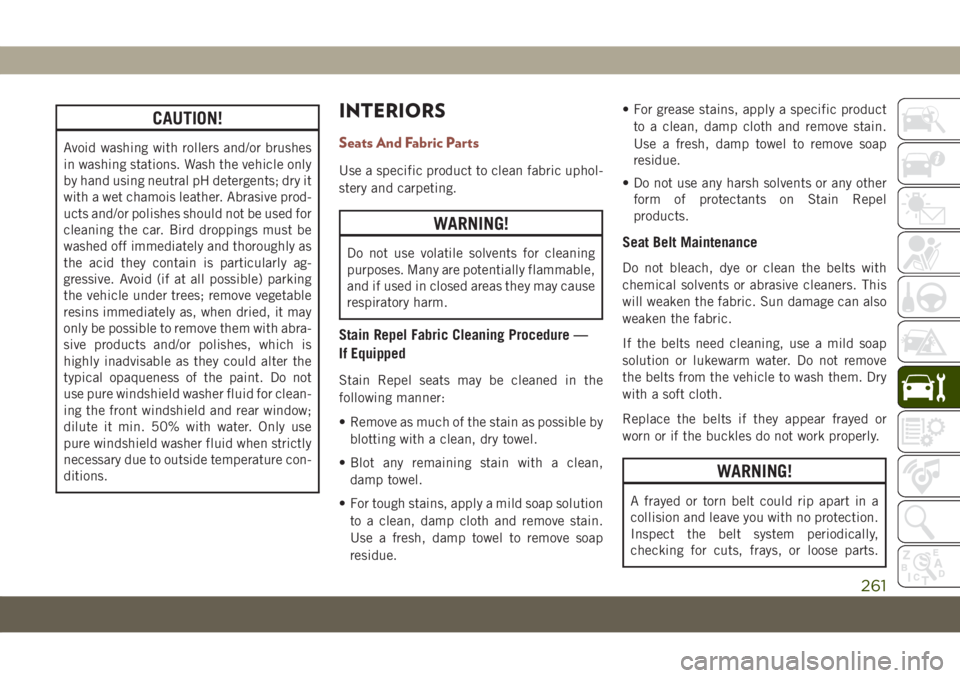
CAUTION!
Avoid washing with rollers and/or brushes
in washing stations. Wash the vehicle only
by hand using neutral pH detergents; dry it
with a wet chamois leather. Abrasive prod-
ucts and/or polishes should not be used for
cleaning the car. Bird droppings must be
washed off immediately and thoroughly as
the acid they contain is particularly ag-
gressive. Avoid (if at all possible) parking
the vehicle under trees; remove vegetable
resins immediately as, when dried, it may
only be possible to remove them with abra-
sive products and/or polishes, which is
highly inadvisable as they could alter the
typical opaqueness of the paint. Do not
use pure windshield washer fluid for clean-
ing the front windshield and rear window;
dilute it min. 50% with water. Only use
pure windshield washer fluid when strictly
necessary due to outside temperature con-
ditions.
INTERIORS
Seats And Fabric Parts
Use a specific product to clean fabric uphol-
stery and carpeting.
WARNING!
Do not use volatile solvents for cleaning
purposes. Many are potentially flammable,
and if used in closed areas they may cause
respiratory harm.
Stain Repel Fabric Cleaning Procedure —
If Equipped
Stain Repel seats may be cleaned in the
following manner:
• Remove as much of the stain as possible by
blotting with a clean, dry towel.
• Blot any remaining stain with a clean,
damp towel.
• For tough stains, apply a mild soap solution
to a clean, damp cloth and remove stain.
Use a fresh, damp towel to remove soap
residue.• For grease stains, apply a specific product
to a clean, damp cloth and remove stain.
Use a fresh, damp towel to remove soap
residue.
• Do not use any harsh solvents or any other
form of protectants on Stain Repel
products.
Seat Belt Maintenance
Do not bleach, dye or clean the belts with
chemical solvents or abrasive cleaners. This
will weaken the fabric. Sun damage can also
weaken the fabric.
If the belts need cleaning, use a mild soap
solution or lukewarm water. Do not remove
the belts from the vehicle to wash them. Dry
with a soft cloth.
Replace the belts if they appear frayed or
worn or if the buckles do not work properly.
WARNING!
A frayed or torn belt could rip apart in a
collision and leave you with no protection.
Inspect the belt system periodically,
checking for cuts, frays, or loose parts.
261
Page 264 of 362
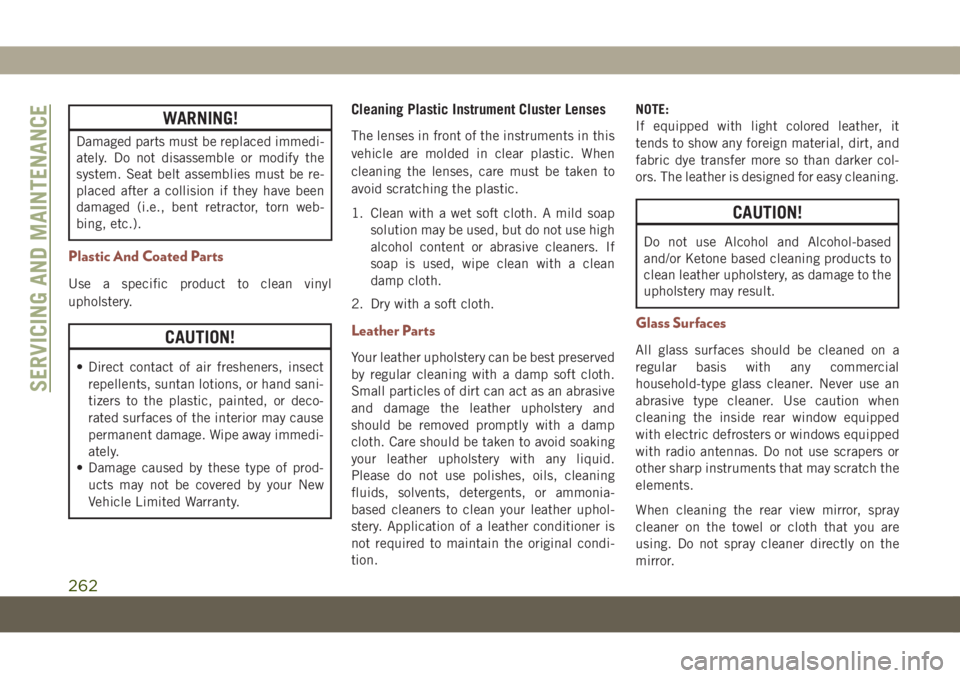
WARNING!
Damaged parts must be replaced immedi-
ately. Do not disassemble or modify the
system. Seat belt assemblies must be re-
placed after a collision if they have been
damaged (i.e., bent retractor, torn web-
bing, etc.).
Plastic And Coated Parts
Use a specific product to clean vinyl
upholstery.
CAUTION!
• Direct contact of air fresheners, insect
repellents, suntan lotions, or hand sani-
tizers to the plastic, painted, or deco-
rated surfaces of the interior may cause
permanent damage. Wipe away immedi-
ately.
• Damage caused by these type of prod-
ucts may not be covered by your New
Vehicle Limited Warranty.
Cleaning Plastic Instrument Cluster Lenses
The lenses in front of the instruments in this
vehicle are molded in clear plastic. When
cleaning the lenses, care must be taken to
avoid scratching the plastic.
1. Clean with a wet soft cloth. A mild soap
solution may be used, but do not use high
alcohol content or abrasive cleaners. If
soap is used, wipe clean with a clean
damp cloth.
2. Dry with a soft cloth.
Leather Parts
Your leather upholstery can be best preserved
by regular cleaning with a damp soft cloth.
Small particles of dirt can act as an abrasive
and damage the leather upholstery and
should be removed promptly with a damp
cloth. Care should be taken to avoid soaking
your leather upholstery with any liquid.
Please do not use polishes, oils, cleaning
fluids, solvents, detergents, or ammonia-
based cleaners to clean your leather uphol-
stery. Application of a leather conditioner is
not required to maintain the original condi-
tion.NOTE:
If equipped with light colored leather, it
tends to show any foreign material, dirt, and
fabric dye transfer more so than darker col-
ors. The leather is designed for easy cleaning.
CAUTION!
Do not use Alcohol and Alcohol-based
and/or Ketone based cleaning products to
clean leather upholstery, as damage to the
upholstery may result.
Glass Surfaces
All glass surfaces should be cleaned on a
regular basis with any commercial
household-type glass cleaner. Never use an
abrasive type cleaner. Use caution when
cleaning the inside rear window equipped
with electric defrosters or windows equipped
with radio antennas. Do not use scrapers or
other sharp instruments that may scratch the
elements.
When cleaning the rear view mirror, spray
cleaner on the towel or cloth that you are
using. Do not spray cleaner directly on the
mirror.
SERVICING AND MAINTENANCE
262
Page 265 of 362
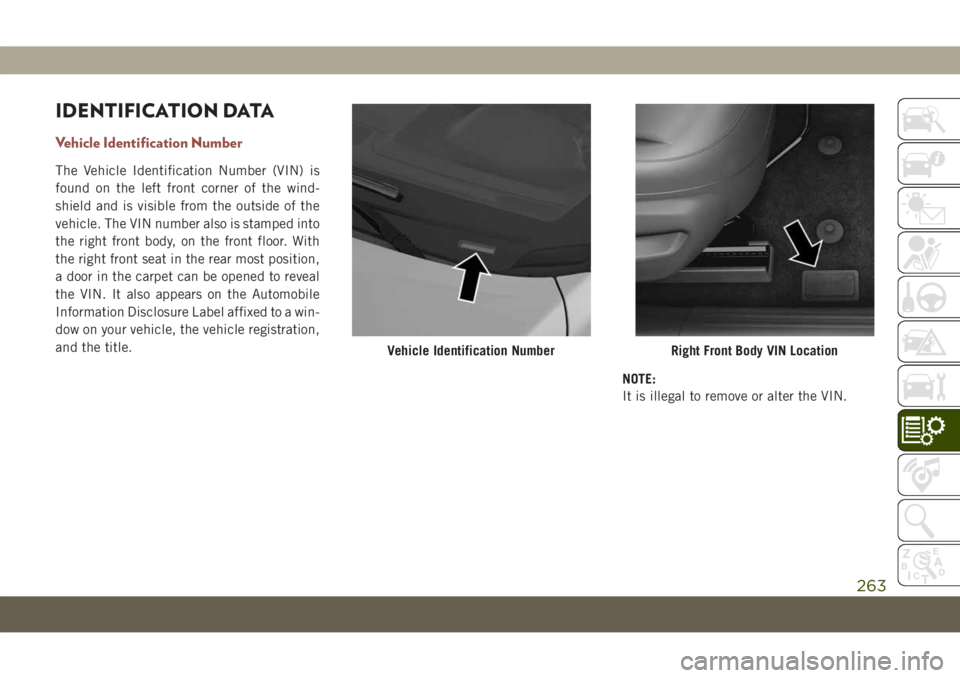
IDENTIFICATION DATA
Vehicle Identification Number
The Vehicle Identification Number (VIN) is
found on the left front corner of the wind-
shield and is visible from the outside of the
vehicle. The VIN number also is stamped into
the right front body, on the front floor. With
the right front seat in the rear most position,
a door in the carpet can be opened to reveal
the VIN. It also appears on the Automobile
Information Disclosure Label affixed to a win-
dow on your vehicle, the vehicle registration,
and the title.
NOTE:
It is illegal to remove or alter the VIN.
Vehicle Identification NumberRight Front Body VIN Location
263
Page 266 of 362
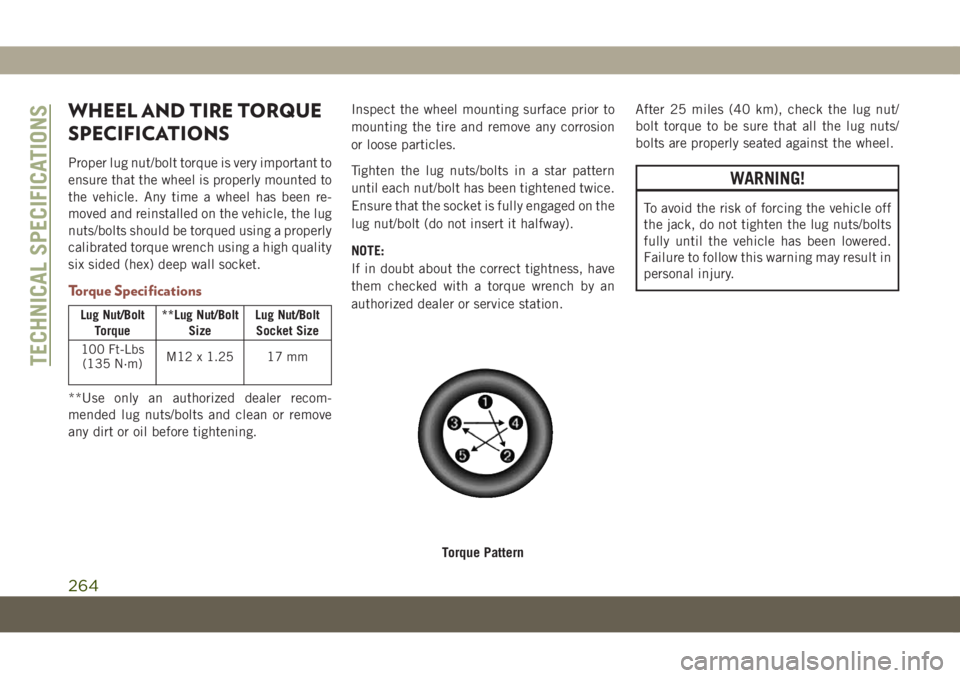
WHEEL AND TIRE TORQUE
SPECIFICATIONS
Proper lug nut/bolt torque is very important to
ensure that the wheel is properly mounted to
the vehicle. Any time a wheel has been re-
moved and reinstalled on the vehicle, the lug
nuts/bolts should be torqued using a properly
calibrated torque wrench using a high quality
six sided (hex) deep wall socket.
Torque Specifications
Lug Nut/Bolt
Torque**Lug Nut/Bolt
SizeLug Nut/Bolt
Socket Size
100 Ft-Lbs
(135 N·m)M12 x 1.25 17 mm
**Use only an authorized dealer recom-
mended lug nuts/bolts and clean or remove
any dirt or oil before tightening.Inspect the wheel mounting surface prior to
mounting the tire and remove any corrosion
or loose particles.
Tighten the lug nuts/bolts in a star pattern
until each nut/bolt has been tightened twice.
Ensure that the socket is fully engaged on the
lug nut/bolt (do not insert it halfway).
NOTE:
If in doubt about the correct tightness, have
them checked with a torque wrench by an
authorized dealer or service station.After 25 miles (40 km), check the lug nut/
bolt torque to be sure that all the lug nuts/
bolts are properly seated against the wheel.
WARNING!
To avoid the risk of forcing the vehicle off
the jack, do not tighten the lug nuts/bolts
fully until the vehicle has been lowered.
Failure to follow this warning may result in
personal injury.
Torque Pattern
TECHNICAL SPECIFICATIONS
264
Page 267 of 362
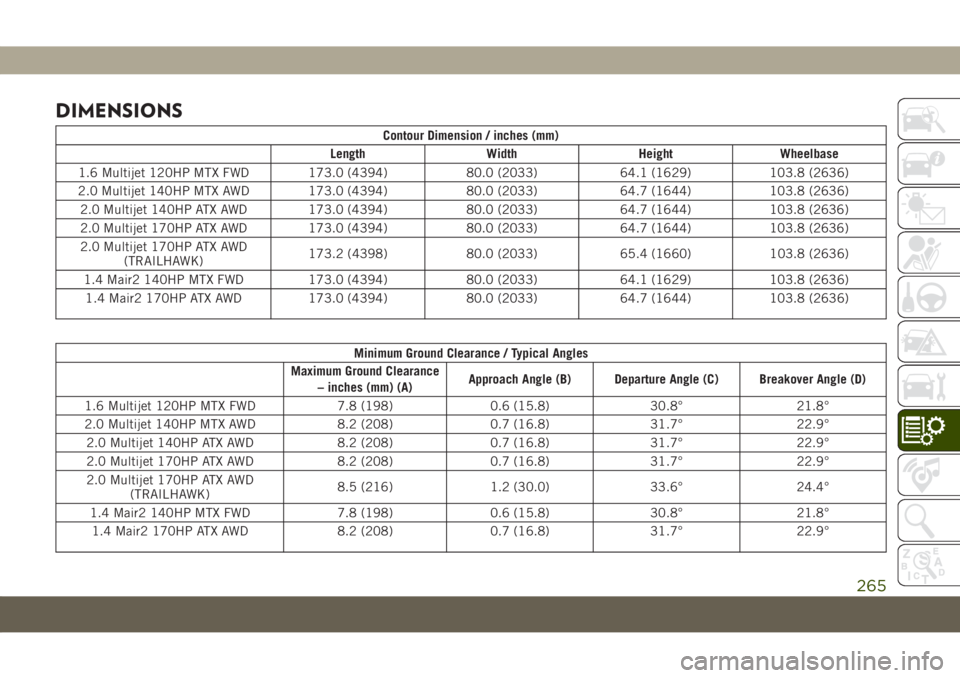
DIMENSIONS
Contour Dimension / inches (mm)
Length Width Height Wheelbase
1.6 Multijet 120HP MTX FWD 173.0 (4394) 80.0 (2033) 64.1 (1629) 103.8 (2636)
2.0 Multijet 140HP MTX AWD 173.0 (4394) 80.0 (2033) 64.7 (1644) 103.8 (2636)
2.0 Multijet 140HP ATX AWD 173.0 (4394) 80.0 (2033) 64.7 (1644) 103.8 (2636)
2.0 Multijet 170HP ATX AWD 173.0 (4394) 80.0 (2033) 64.7 (1644) 103.8 (2636)
2.0 Multijet 170HP ATX AWD
(TRAILHAWK)173.2 (4398) 80.0 (2033) 65.4 (1660) 103.8 (2636)
1.4 Mair2 140HP MTX FWD 173.0 (4394) 80.0 (2033) 64.1 (1629) 103.8 (2636)
1.4 Mair2 170HP ATX AWD 173.0 (4394) 80.0 (2033) 64.7 (1644) 103.8 (2636)
Minimum Ground Clearance / Typical Angles
Maximum Ground Clearance
– inches (mm) (A)Approach Angle (B) Departure Angle (C) Breakover Angle (D)
1.6 Multijet 120HP MTX FWD 7.8 (198) 0.6 (15.8) 30.8° 21.8°
2.0 Multijet 140HP MTX AWD 8.2 (208) 0.7 (16.8) 31.7° 22.9°
2.0 Multijet 140HP ATX AWD 8.2 (208) 0.7 (16.8) 31.7° 22.9°
2.0 Multijet 170HP ATX AWD 8.2 (208) 0.7 (16.8) 31.7° 22.9°
2.0 Multijet 170HP ATX AWD
(TRAILHAWK)8.5 (216) 1.2 (30.0) 33.6° 24.4°
1.4 Mair2 140HP MTX FWD 7.8 (198) 0.6 (15.8) 30.8° 21.8°
1.4 Mair2 170HP ATX AWD 8.2 (208) 0.7 (16.8) 31.7° 22.9°
265
Page 268 of 362

Minimum Ground Clearance (Reference A)
The clearance value is measured next to the
lower edge of the differential. This value also
defines those for the “Approach Angle” the
“Departure Angle” and the “Breakover Angle”.
Dimensions are expressed in inches (mm)
and refer to the vehicle equipped with its
original tires.
Approach Angle (Reference B)
The approach angle is determined by the
horizontal line of the road surface, and by the
tangent line passing between the front wheel,
and the most projecting low point of the car.
The wider the angle, the lower the chance to
hit an obstacle with the body or chassis,
when climbing a steep slope or overcoming
an obstacle.
Departure Angle (Reference C)
The departure angle is determined by the
same lines of the “Approach Angle”, and
refers to the rear part of the vehicle.Breakover Angle (Reference D)
The value of the “Breakover Angle” is linked
to the ground clearance of the vehicle and
indicates the attitude of the vehicle to over-
come a wedge, more or less steep, preventing
the vehicle from resting on the ground with
the body or chassis after touching the wedge
with its lowest and most projecting parts
(usually the underbody), because this would
highly reduce wheel grip.
The wheels, without a suitable grip to the
ground, will not have sufficient hold to move
the vehicle, and will surge.
The higher the ground clearance, the wider
the breakover angle. Always bear in mind that
the higher the ground clearance, the lower
the stability, due to a higher center of gravity
which reduces the side rollover angle.Ground Clearance / Typical Angles
Measurements
TECHNICAL SPECIFICATIONS
266
Page 269 of 362
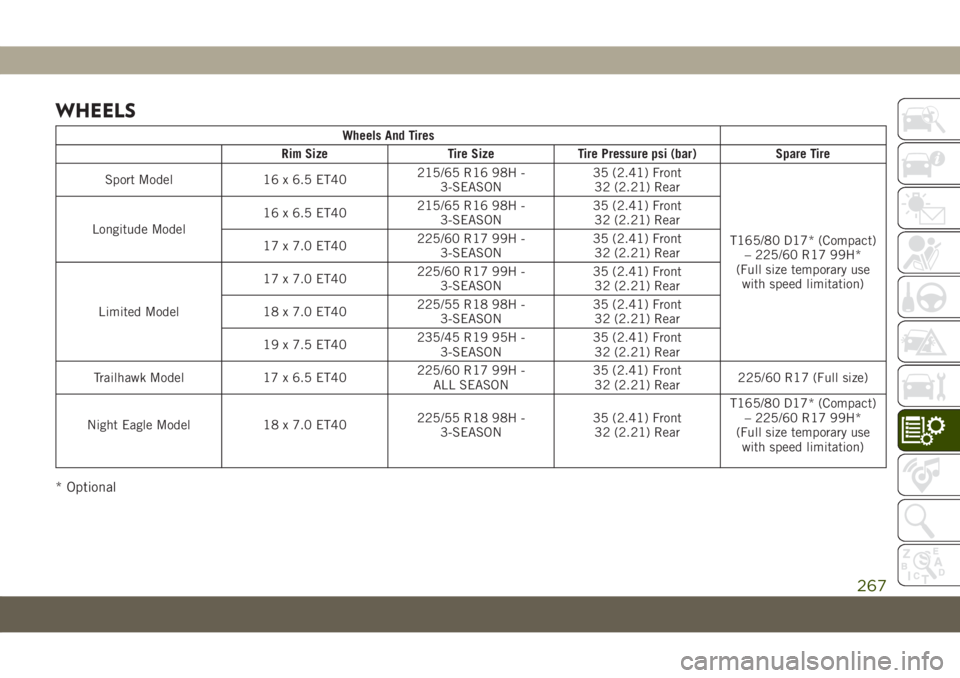
WHEELS
Wheels And Tires
Rim Size Tire Size Tire Pressure psi (bar) Spare Tire
Sport Model 16 x 6.5 ET40215/65 R16 98H -
3-SEASON35 (2.41) Front
32 (2.21) Rear
T165/80 D17* (Compact)
– 225/60 R17 99H*
(Full size temporary use
with speed limitation) Longitude Model16 x 6.5 ET40215/65 R16 98H -
3-SEASON35 (2.41) Front
32 (2.21) Rear
17 x 7.0 ET40225/60 R17 99H -
3-SEASON35 (2.41) Front
32 (2.21) Rear
Limited Model17 x 7.0 ET40225/60 R17 99H -
3-SEASON35 (2.41) Front
32 (2.21) Rear
18 x 7.0 ET40225/55 R18 98H -
3-SEASON35 (2.41) Front
32 (2.21) Rear
19 x 7.5 ET40235/45 R19 95H -
3-SEASON35 (2.41) Front
32 (2.21) Rear
Trailhawk Model 17 x 6.5 ET40225/60 R17 99H -
ALL SEASON35 (2.41) Front
32 (2.21) Rear225/60 R17 (Full size)
Night Eagle Model 18 x 7.0 ET40225/55 R18 98H -
3-SEASON35 (2.41) Front
32 (2.21) RearT165/80 D17* (Compact)
– 225/60 R17 99H*
(Full size temporary use
with speed limitation)
* Optional
267
Page 270 of 362
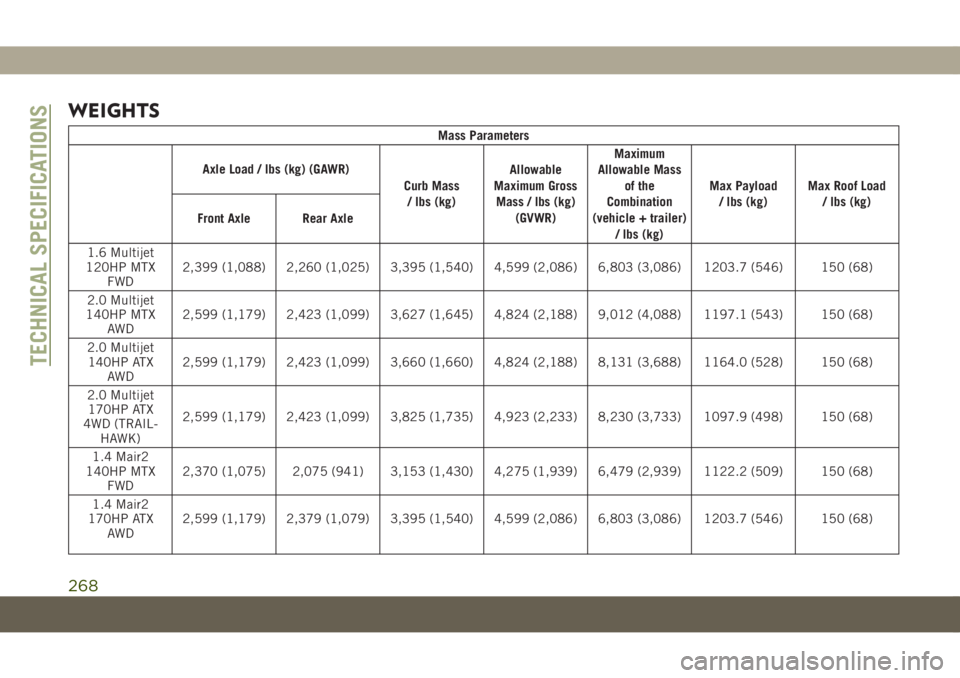
WEIGHTS
Mass Parameters
Axle Load / lbs (kg) (GAWR)
Curb Mass
/ lbs (kg)Allowable
Maximum Gross
Mass / lbs (kg)
(GVWR)Maximum
Allowable Mass
of the
Combination
(vehicle + trailer)
/ lbs (kg)Max Payload
/ lbs (kg)Max Roof Load
/ lbs (kg)
Front Axle Rear Axle
1.6 Multijet
120HP MTX
FWD2,399 (1,088) 2,260 (1,025) 3,395 (1,540) 4,599 (2,086) 6,803 (3,086) 1203.7 (546) 150 (68)
2.0 Multijet
140HP MTX
AWD2,599 (1,179) 2,423 (1,099) 3,627 (1,645) 4,824 (2,188) 9,012 (4,088) 1197.1 (543) 150 (68)
2.0 Multijet
140HP ATX
AWD2,599 (1,179) 2,423 (1,099) 3,660 (1,660) 4,824 (2,188) 8,131 (3,688) 1164.0 (528) 150 (68)
2.0 Multijet
170HP ATX
4WD (TRAIL-
HAWK)2,599 (1,179) 2,423 (1,099) 3,825 (1,735) 4,923 (2,233) 8,230 (3,733) 1097.9 (498) 150 (68)
1.4 Mair2
140HP MTX
FWD2,370 (1,075) 2,075 (941) 3,153 (1,430) 4,275 (1,939) 6,479 (2,939) 1122.2 (509) 150 (68)
1.4 Mair2
170HP ATX
AWD2,599 (1,179) 2,379 (1,079) 3,395 (1,540) 4,599 (2,086) 6,803 (3,086) 1203.7 (546) 150 (68)
TECHNICAL SPECIFICATIONS
268